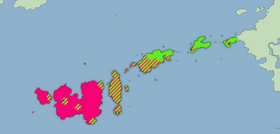Soc'ul': Difference between revisions
Jump to navigation
Jump to search
No edit summary Tags: Mobile edit Mobile web edit |
|||
| Line 17: | Line 17: | ||
|map = PollasenaMapGlowPNG2.png | |map = PollasenaMapGlowPNG2.png | ||
|mapsize = 280px | |mapsize = 280px | ||
|mapcaption = Range map of Soc'ul' and [[Knrawi]] | |mapcaption = Range map of Soc'ul' (green) and [[Knrawi]] (pink) | ||
|notice = IPA | |notice = IPA | ||
}} | }} | ||
Revision as of 22:16, 1 April 2023
| Soc'ul' | |
|---|---|
| soc'ul' | |
 Jul soc'ul', "Soc'ul' language" | |
| Pronunciation | [so̞˧kʷʰu˩lˀ] |
| Created by | Dillon Hartwig |
| Date | 2020 |
| Setting | Pollasena |
| Native to | Knrawi Isles |
Wasc
| |
Early form | |
| Official status | |
Official language in | Knrawi Empire |
Range map of Soc'ul' (green) and Knrawi (pink) | |
Soc'ul' (Soc'ul': [so̞˧kʷʰu˩lˀ]) is a Wasc language spoken primarily by the Cuoñ'o people, with strong influence from Knrawi and other languages of the Knrawi Isles.
Etymology
Soc'ul', the language's autonym, is inherited from the Pre-Soc'ul' autonym səkʰulːa, from Wascotl *(cek)-cek-sole-la "our tongue".
Introduction
Phonology
Orthography
Soc'ul' is written with the Wacag logography. Its romanization is as follows.
| A a | Á á | Ā ā | B b | B' b' | C c | C' c' | D d | D' d' | E e | É é | Ē ē | H h | I i | Í í | Ī ī |
| J j | L l | L' l' | M m | M' m' | N n | N' n' | Ñ ñ | Ñ' ñ' | O o | Ó ó | Ō ō | P p | Pf pf | R r | R' r' |
| S s | T t | Ts ts | Tx tx | T' t' | U u | Ú ú | Ū ū | V v | V' v' | X x | Y y | Ý ý | Z z | Z' z' |
This romanization matches IPA except
- ⟨c⟩, ⟨e⟩, ⟨h⟩, ⟨j⟩, ⟨ñ⟩, ⟨x⟩, and ⟨y⟩ represent /k/, /ə/, /ʔ/, /x/, /ŋ/, /ʃ/, and /ɰ/
- ⟨pm⟩, ⟨tn⟩, ⟨cñ⟩, ⟨ts⟩, and ⟨tx⟩ represent /ᵖm/, /ᵗn/, /ᵏŋ/, /t͡s/, and /t͡ʃ/
- Apostrophes mark glottalization and aspiration.
- Acutes and macrons mark long and overlong vowels respectively, except in ⟨ý⟩ in which it marks glottalization.
- Labialization and palatalization are marked by surrounding vowel letters.
Consonants
| Labial/ labiodental |
Alveolar | Post- alveolar |
Palatalized velar/ palatal |
Velar | Labialized velar | Glottal | ||||||||||||||||||||||
|---|---|---|---|---|---|---|---|---|---|---|---|---|---|---|---|---|---|---|---|---|---|---|---|---|---|---|---|---|
| Nasal | ᵖm | m | ᵖmˀ | mˀ | ᵗn | n | nˀ | ᵗnˀ | ᵏŋʲ | ŋʲ | ᵏŋʲˀ | ŋʲˀ | ᵏŋ | ŋ | ᵏŋˀ | ŋˀ | ᵏŋʷ | ŋʷ | ᵏŋʷˀ | ŋʷˀ | ||||||||
| Stop | b | bˀ | t | d | tʰ | dˀ | kʲ | kʲʰ | k | kʰ | kʷ | kʷʰ | ʔ | |||||||||||||||
| Affricate | t͡s | t͡ʃ | ||||||||||||||||||||||||||
| Fricative | v | vˀ | s | z | zˀ | ʃ | xʲ | (ʝ) | (ʝˀ) | x | (ɣ) | (ɣˀ) | xʷ | (ɣʷ) | (ɣʷˀ) | |||||||||||||
| Approximant | l | lˀ | (j) | (jˀ) | (ɰ) | (ɰˀ) | (w) | (wˀ) | ||||||||||||||||||||
| Trill | r | rˀ | ||||||||||||||||||||||||||
Notes:
- Glottalized stops are realized as implosive by some speaker either in free variation or word-initially
- [j(ˀ)] and [w(ˀ)] are allophones of /i(ː)/ and /u(ː)/ adjacent to vowels
- [j(ˀ)], /ɰ(ˀ)/, and [w(ˀ)] are realized as [ʝ(ˀ)], [ɣ(ˀ)], and [ɣʷ(ˀ)] adjacent to high vowels
Vowels
| Front | Central | Back | ||
|---|---|---|---|---|
| Close | i | (y) | u | |
| Close-mid | ə | (o̞) | ||
| Open | a | (ɒ) | ||
Notes:
- All vowels can be long or overlong
- [y], [o̞], and [ɒ] are allophones of /i/, /ə/, and /a/ adjacent to labialized consonants except allophones of /u(ː)/
